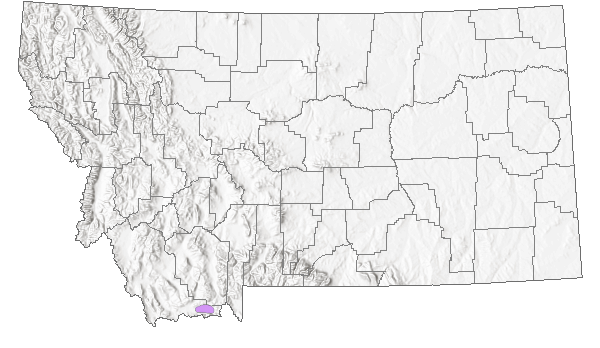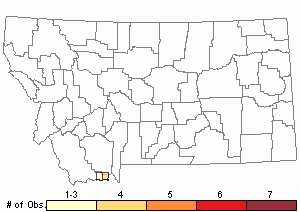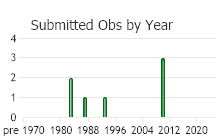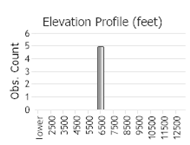View in other NatureServe Network Field Guides
NatureServe
Montana
Utah
Wyoming
Idaho
Wisconsin
British Columbia
South Carolina
Yukon
California
New York
Pale Evening-primrose - Oenothera pallida ssp. pallida
Other Names:
Oenothera pallida var. idahoensis
State Rank Reason (see State Rank above)
Limited in Montana to the sandhills of the Centennial Valley in Beaverhead County. A reduction in natural disturbances, including fire, ungulate grazing and pocket gopher activity has led to greater dune stabilization and reduced the extent of early successional (blowout) habitat in the area.
- Details on Status Ranking and Review
Population Size
Score2-3 - Very Small to Small: Population size is imprecisely known but is believed to be <10,000 individuals.
Range Extent
Score3 - Local Endemic or Very Small Montana Range: Generally restricted to an area <10,000 sq. miles (equivalent to the combined area of Phillips and Valley Counties) or <6 Sub-basins (4th code watersheds) Range-wide OR limited to one Sub-basin in Montana
Area of Occupancy
Score3 - Very Low: Generally occurring in 3 or fewer Subwatersheds (6th Code HUC’s).
Environmental Specificity
Score2 - High: Species is restricted to a highly specialized and limited habitat and is typically dependent upon unaltered, high-quality habitat (C Values of 8-10).
Trends
ScoreNA - Rank factor not assessed.
Threats
ScoreNA - Rank factor not assessed.
Intrinsic Vulnerability
Score1 - Moderate Vulnerability: Specific biological attributes, unusual life history characteristics or limited reproductive potential makes the species susceptible to extirpation from stochastic events or other adverse impacts to its habitat and slow to recover.
Raw Conservation Status Score
Score
11 to 12 total points scored out of a possible 13 (Rarity factors only).
General Description
Pale Evening-primrose is a rhizomatous perennial with whitish, peeling bark and erect or ascending, often branched stems that are up to 2 dm high. The strap-shaped leaves have entire to broadly-toothed margins and short petioles and are 2-6 cm long, becoming smaller up the stem. Foliage is sparsely covered with grayish, appressed hairs. The flowers are borne on their long, stalk-like ovary in the axils of the crowded upper leaves. The flowers have 4 partly united, reflexed sepals that are 1-2 cm long. The 4 white petals become pink with age, are 15-30 mm long, and are wedge-shaped with broad tips. There are 8 stamens and a long style with an x-shaped stigma. Each flower surmounts a 15-35 mm long ovary that matures into a many-seeded capsule.
Lesica (2012) recognizes two subspecies for Montana: subsp. pallida and subsp. trichocalyx (Nutt.) Munz & W.M. Klein.
Phenology
Flowering occurs in July-early August.
Diagnostic Characteristics
Our only subspecies of Oenothera pallida in the state. There are two other species of white-flowered, leafy-stemmed evening-primroses in Montana. Oenothera albicaulis is a more delicate, taprooted annual. Oenothera nuttallii is very similar, but the inflorescence is glandular.
Species Range
Montana Range
Range Descriptions

 Native
Native
Range Comments
BC south to AZ and NM (Lesica et al. 2012. Manual of Montana Vascular Plants. BRIT Press. Fort Worth, TX).
Observations in Montana Natural Heritage Program Database
Number of Observations: 8
(Click on the following maps and charts to see full sized version)
Map Help and Descriptions
Relative Density

Recency



 (Observations spanning multiple months or years are excluded from time charts)
(Observations spanning multiple months or years are excluded from time charts)
Habitat
This plant is restricted to early successional sandy habitats. It grows on the crests and slopes of blowout areas in the Centennial Valley sandhills. Common associated species include Agropyron dasystachyum, Stipa comata, Cryptantha fendleri, Eriogonum ovalifolium, Psoralea tenuiflora, Phacelia hastata, Astragalus ceramicus, and Allium textile.
Ecological Systems Associated with this Species
Ecology
POLLINATORS The following animal species have been reported as pollinators of this plant species or its genus where their geographic ranges overlap:
Bombus pensylvanicus and
Bombus impatiens (Colla and Dumesh 2010).
Management
Pale evening-primrose grows in the sand dune region of the Centennial Valley where there is light to moderate grazing (Culver 1993). In 1987, the populations were reported to be thriving, however in 1993, only a few small populations were observed. Like other rare plants of the sandhills, this species requires the open sand of early successional areas, and declines when plant succession leads to later successional stages in which vegetation colonizes areas of formerly open sand (Lesica and Cooper 1998). Historically, the diversity of sandhills plant communities was influenced by a fire cycle of 20-30 years and pocket gopher (Thomomys talpoides) activity which maintained a significant proportion of early successional habitat. Pale evening-primrose would benefit from restoration of the fire regime and moderate grazing, at least in years following burns. Severe destabilization of the dunes, e.g. from off-road vehicles, could damage its habitat.
Stewardship Responsibility
Threats or Limiting Factors
STATE THREAT SCORE REASON
Reported threats to Montana's populations of Pale Evening-primrose (Oenothera pallida ssp. pallida) are currently assigned as unknown. Potential threats due to management actions that exclude disturbance in appropriate habitat need to be substantiated before a threat rank can be assigned (MTNHP Threat Assessment 2021).
References
- Literature Cited AboveLegend:
 View Online Publication
View Online Publication Colla, S.R. and S. Dumesh. 2010. The bumble bees of southern Ontario: notes on natural history and distribution. Journal of the Entomological Society of Ontario 141:39-68.
Colla, S.R. and S. Dumesh. 2010. The bumble bees of southern Ontario: notes on natural history and distribution. Journal of the Entomological Society of Ontario 141:39-68. Lesica, P., M.T. Lavin, and P.F. Stickney. 2012. Manual of Montana Vascular Plants. Fort Worth, TX: BRIT Press. viii + 771 p.
Lesica, P., M.T. Lavin, and P.F. Stickney. 2012. Manual of Montana Vascular Plants. Fort Worth, TX: BRIT Press. viii + 771 p. MTNHP Threat Assessment. 2021. State Threat Score Assignment and Assessment of Reported Threats from 2006 to 2021 for State-listed Vascular Plants. Botany Program, Montana Natural Heritage Program, Helena, Montana.
MTNHP Threat Assessment. 2021. State Threat Score Assignment and Assessment of Reported Threats from 2006 to 2021 for State-listed Vascular Plants. Botany Program, Montana Natural Heritage Program, Helena, Montana.
- Additional ReferencesLegend:
 View Online Publication
View Online Publication
Do you know of a citation we're missing? Culver, D.R. 1994. Floristic analysis of the Centennial Region, Montana. M.Sc. Thesis. Montana State University, Bozeman. 199 pp.
Culver, D.R. 1994. Floristic analysis of the Centennial Region, Montana. M.Sc. Thesis. Montana State University, Bozeman. 199 pp. Lesica, P., M.T. Lavin, and P.F. Stickney. 2022. Manual of Montana Vascular Plants, Second Edition. Fort Worth, TX: BRIT Press. viii + 779 p.
Lesica, P., M.T. Lavin, and P.F. Stickney. 2022. Manual of Montana Vascular Plants, Second Edition. Fort Worth, TX: BRIT Press. viii + 779 p.
- Web Search Engines for Articles on "Pale Evening-primrose"





